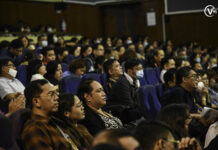ESTABLISHING a crisis management office in UST is essential to improving disaster preparedness for impending natural hazards, an emergency training professional said.
Juliano Parena Jr., emergency training officer at the Fire Emergency Assistance Group – a non-profit emergency and rescue unit based in Metro Manila – called on University officials to form a dedicated crisis management office to unify the local Incident Command System (ICS) and the existing crisis management committee into one unit.
“If there is nobody looking at and evaluating our emergency measures, then we’d be caught unprepared. We need an office that regularly evaluates and tells us that our procedures are not good,” Parena told the Varsitarian.
Developed in the United States, the ICS is a standardized approach to the command, control and coordination of emergency response. The ICS also provides responders and emergency personnel a systematized hierarchy.
Parena, who teaches applied math in the College of Science, admitted that the incident commanders get confused on who is going to take charge when disasters arise, saying they are “still professors and are still under their college officials.”
“We can’t give the order to evacuate our building once a disaster happens because we still have our college administrators…That is why we need to create the office, to authorize incident commanders to take charge of the emergency and evacuation,” he said.
Interviews conducted by the Varsitarian showed that majority of the University’s incident commanders want to have an institutionalized crisis management office.
Parena said the establishment of the crisis management office would be expensive, but would reduce casualties and damage to structures in UST.
“It is a good investment because the cost of not having one (crisis management office) would effect a bigger cost when a crisis or a disaster strikes the University and we are not well-prepared,” he said.
Parena added that without a proper and functioning office for crisis management, the University might take time to recover from damage to its structures.
‘Irregular drills and rare meetings’
Parena said the drills conducted in the University were irregular. Incident commanders rarely meet with the crisis management committee.
However, Crisis Management Committee Chairman Fr. Roland Castro, O.P. said meetings with other committee members and heads were on hold due to conflicts in their schedules.
“We are always in touch and hopefully, nothing untoward will happen until the end of the school year,” Castro said in a chance interview.
UST Security Chief Joseph Badinas said members of the central and local committees of the crisis management unit were prepared for disasters.
“I am not sure on how frequent the [crisis management committee] selects its members but the structure is still existing. The structure is still working during times of calamity,” said Badinas, crisis management committee chairman for security.
The University Crisis Management Committee was put up under the UST crisis management manual crafted in 2007. The heads of the committee are the vice rector for finance and the director of the Office for Student Affairs (OSA).
Other officers of the crisis management committee are to be appointed from the Office of the Secretary General, Facilities Management Office, Human Resource Department, Purchasing Office, Public Affairs Office, UST Health Service, Simbahayan Community Development Office, Safety and Security Office, Santisimo Rosario Parish and UST Hospital.
They are supposed to take charge of first aid, search and rescue, salvage and recovery, logistics, communication and transportation.
Drafting of the manual was initiated by then vice rector for finance Fr. Manuel Roux, O.P., who served as chief incident commander, and former OSA director Evelyn Songco, who served as deputy incident commander.
The University’s own ICS was established in 2013. Colleges and buildings were each assigned an incident commander chosen by their respective directors and deans.
The manual has procedures on disasters such as typhoons, earthquakes, fire and bomb threats.
‘Dysfunctional procedures’
Citing the Level 3 intensity earthquake that was felt in the University last April 8, Parena said students could have been in danger because of a dysfunctional chain of command.
“They are not supposed to exit the building, they have to do the ‘duck, cover and hold’ drill first. Plus the classes had been disrupted for the whole day, and the problem was, no one was claiming responsibility for the evacuation command,” he said.
“Monthly rounds should be conducted in the buildings to ensure that people in charge of the building are still maintaining facilities and protocols, and this should be warranted by the said institutionalized crisis management office” he added.
Castro said the local committees along with the UST Red Cross have their own protocols for earthquakes.
“They were able to manage calmly and peacefully because they have already their own protocols as far as earthquakes are concerned,” he said.




















